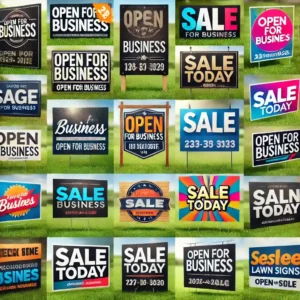In the competitive landscape of the culinary world, restaurant signs play a pivotal role in attracting patrons and conveying the essence of a dining establishment. They serve not only as navigational aids but also as critical components of a restaurant’s branding strategy. From the design elements to the materials used, custom restaurant signs can make a significant impact on a restaurant’s visibility and overall success.
The Importance of Restaurant Signs
The primary function of a restaurant sign is to communicate. Whether it’s the name of the restaurant or its specialty dishes, these signs convey vital information to potential customers. A well-designed sign can entice passersby, guiding them to your establishment while simultaneously reflecting the ambiance and ethos of the dining experience offered.
In urban centers like Toronto, where competition is fierce, the visibility provided by restaurant signs in Toronto becomes even more crucial. With thousands of dining options available, a captivating sign can mean the difference between a bustling restaurant and one that remains unnoticed.
Types of Restaurant Signs
When it comes to custom restaurant signage, there are several types to consider, each serving a unique purpose:
| Type of Sign | Description |
| Channel Letters | These are 3D letters that can be illuminated for greater visibility, ideal for both day and night. |
| Monument Signs | These ground-level signs provide a lasting first impression, perfect for freestanding locations. |
| Blade Signs | Mounted perpendicular to the building, blade signs are excellent for attracting attention from pedestrians. |
| A-Frame Signs | Versatile and portable, A-frame signs can be moved to capture foot traffic and can be easily customized for daily specials. |
| Digital Displays | Offering dynamic content, digital signs can display menus, promotions, or events, making them a flexible option. |
Each type of sign offers distinct advantages, and selecting the right one depends on the restaurant’s branding goals and location.
Design Elements of Custom Restaurant Signs
The design of a custom restaurant sign should harmoniously blend aesthetics and functionality. Color schemes, typography, and imagery are paramount in crafting a visual identity. For instance, a fine-dining restaurant might opt for elegant fonts and subdued colors, while a casual eatery might use vibrant colors and playful graphics.
Restaurant signs should also consider readability from a distance. Clear, bold lettering ensures that even drivers can easily read the sign while passing by. Incorporating the restaurant’s logo into the sign design can further enhance brand recognition and create a cohesive look across all marketing materials.
The Impact of Location
Location is critical when it comes to restaurant signs in Toronto. High-traffic areas or bustling neighborhoods often present the best opportunities for visibility. It’s essential to consider the surrounding architecture and environment. A sign that blends in with its surroundings may go unnoticed, while one that stands out can draw in curious customers.
Additionally, zoning regulations can impact sign design and placement. Understanding local ordinances ensures compliance and avoids potential fines. Working with experienced designers familiar with these regulations can help streamline the process of creating effective signage.
Material Considerations
Choosing the right materials for custom restaurant signage is vital to ensure durability and appeal. Common materials include:
- Acrylic: Lightweight and versatile, acrylic offers a modern look and is suitable for both indoor and outdoor signs.
- Metal: Known for its durability, metal signs can withstand harsh weather conditions, making them ideal for external use.
- Wood: Often associated with rustic charm, wooden signs can add warmth and character to a restaurant’s branding.
The choice of material should align with the restaurant’s overall theme and desired aesthetic.
Lighting and Visibility
Proper lighting is crucial for the effectiveness of restaurant signs. Well-lit signs enhance visibility, particularly during evening hours. Options such as backlighting, spotlights, or neon accents can elevate the sign’s impact, ensuring it remains eye-catching after dark.
Conclusion
In the world of hospitality, restaurant signs are far more than mere markers; they are vital components of a restaurant’s identity and marketing strategy. The right sign not only enhances visibility but also communicates the restaurant’s brand values and dining experience. From the type of sign to the materials and lighting, every decision contributes to the overall effectiveness of the signage.
For restaurants aiming to carve out their niche in bustling locales like Toronto, investing in quality custom restaurant signs is essential. By carefully considering design, materials, and placement, restaurant owners can create signage that not only attracts customers but also fosters a memorable dining experience. In a market where first impressions matter, the significance of restaurant signage cannot be overstated.
FAQ
- What types of signs work best for restaurants?
Popular options include channel letters, monument signs, blade signs, A-frames, and digital displays, each offering unique visibility advantages. - What materials are ideal for restaurant signs?
Common choices are acrylic for modern looks, metal for durability, and wood for rustic charm. - Can signs be illuminated?
Yes, lighting options like backlighting and neon enhance visibility, especially in the evening. - Are there regulations for restaurant signs in Toronto?
Yes, Toronto has specific signage regulations, so it’s best to consult a local expert. - Why use digital signage?
Digital signs allow real-time updates and display dynamic content to engage customers. - How does branding impact signage?
Effective branding in signage helps draw attention and leaves a memorable impression on customers. - How can I make my sign more visible?
Bold fonts, lighting, and strategic placement in high-traffic areas can increase visibility. - Are custom signs expensive?
Custom signs vary in price but often pay off with long-term branding and customer attraction. - Can signs be used for promotions?
Yes, digital and A-frame signs are ideal for displaying specials or events. - How often should signs be updated?
High-quality signs can last years, but periodic updates help keep them fresh and relevant.


